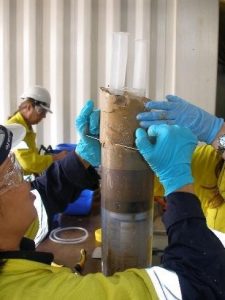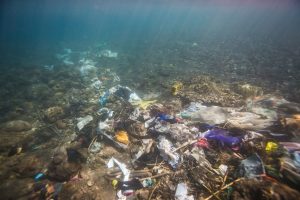Over 14 Million Tons of Microplastics In Our Ocean Depths. Plastic Oceans Experts Weigh In.
The ocean’s seafloor has long been a known hotspot for human pollutants, and scientists are still learning the extent of the damage. A recent study from Australia’s national science agency has revealed a conservative estimate of 14 million tons of microplastics in the deep ocean, the first ever global estimate of its kind.

Researchers at CSIRO collecting microplastic samples.
The Commonwealth Scientific and Industry Research Organization (CSIRO) used a robotic submarine to collect deep-sea sediments from six locations offshore from South Australia. In total, fifty-one subsamples were analyzed, and the results were scaled up to the size of the ocean. Justine Barrett from CSIRO’s Ocean and Atmosphere, who led the study published on October 6th, was quoted as saying, “The results show microplastics are indeed sinking to the ocean floor.”
Microplastics are defined as plastics less than five millimeters long, either the result of plastics intentionally manufactured as such (think microbeads used in cosmetics), or larger plastics that are weathered down over time. Plastics that end up in the ocean are particularly susceptible to these types of breakdowns from their contact with UV rays, salt water, sand, and other abrasive substances. The resulting microplastics are easily ingested by marine life of all sizes.
“We know that bigger plastics can pose a threat to whales, dolphins, and turtles,” says Charlie Rolsky, Director of Science at Plastic Oceans, “but smaller plastics, because of their size, are able to penetrate a lot of ecosystems. They can be mistaken for food and can work their way through the food chain.”
Though the results are troubling—this is double the estimated amount of plastics on the ocean’s surface, and over 25 times higher than previous deep sea studies—they confirm what scientists have long been telling the public: that microplastics are deeply embedded in marine life at an alarming scale.
“It’s reaffirming what we’ve thought,” says Rolsky. “It’s the first time someone has taken the time to quantify microplastics on the ocean floor, which is a unique perspective. What I want to focus on going forward is, why does it matter?”
The amount of plastic entering the ocean is expected to increase in coming years. Scientists are urging people to look at their plastic consumption habits and to reduce their use of single-use plastics especially.

Even simple habit changes, such as foregoing plastic cutlery and straws when ordering takeout, can have larger impacts when adopted on a larger scale. Wide reaching policy changes are also urgently needed to mitigate climate disaster. Though the study was based in Australia, the impacts are, of course, global, and Rolsky encourages citizens everywhere to use elections as an opportunity to make their climate concerns heard. “I always stress to look at the candidates environmental records,” he says. “It’s a crucial time for us, it’s a crucial time for the climate, and we need to lean more on science.”
The results of the study can feel overwhelming when considering the sheer volume of microplastics in the ocean, let alone the environmental impacts, but scientists hope that this can be used as another opportunity to urge people to reconsider their relationship to plastics. “We need to stop asking ‘How big is the problem?’” says Julie Andersen. “We all know it’s big. Instead, we have to start asking ourselves, with each plastic item we encounter, ‘Where did this come from and where will it go?’”
Anna Fitzpatrick is a Toronto-based writer. She has written for The New Yorker, The Hairpin, Hazlitt, Rookie Mag, Rolling Stone, The New York Times Magazine, Vice, The Globe & Mail and more. She is the author of the children’s book Margot and the Moon Landing. You can learn more about her on her website and Instagram.

Trackback: tải sunwin
Trackback: รับทำ SEO
Trackback: rtp dultogel
Trackback: เว็บพนันเกาหลี
Trackback: PGSLOT ปั่นฟรีโบนัสแตก
Trackback: SHOPEE สล็อต
Trackback: วิธีคิด บอลสเต็ปได้ครึ่ง
Trackback: webcams